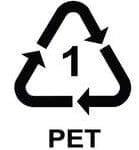Introduction
Polyester (PET) is the most widely used fibre in the apparel industry, accounting for around 52% of the total volume of fibres produced globally. The apparel industry accounts for around 32 million tons of the 57 million tons of polyester used each year [1]. It is used widely in technical textiles as well.
Polyester is polymerized from the monomer ethylene. Polyesters can be thermoset or thermoplastic, saturated or unsaturated. The two main types of polyester are PCDT (poly-1, 4-cyclohexylene-dimethylene terephthalate) and PET (polyethylene terephthalate) [2].
PET
PET is among those plastics which are an important part of your everyday life. It is an important commercial polymer having application ranging from packaging, fabrics, films, moulded parts for automotive, electronics… and many more. You can find this famous clear plastic around you as water bottle or soda bottle container.

Fig. 1: PET recycling code
Polyethylene terephthalate (PET or PETE) is a general-purpose thermoplastic polymer which belongs to the polyester family of polymers. Polyester resins are known for their excellent combination of properties such as mechanical, thermal, chemical resistance as well as dimensional stability.
Polyethylene Terephthalate or PET products are 100% recyclable and is the most recycled plastic worldwide. PET can be easily identified by its recycling code #1. Low diffusion coefficient makes PET much more suitable than other plastic materials for use as a recovered, recycled material.
Post-consumer PET bottles are collected and processed through a series of special washing processes or by a chemical treatment to break down the PET into its raw materials or intermediates which are further used to produce recycled PET (rPET) flakes. PET bottles and containers that find their way to the landfill pose no risk of harm or leaching. Since the polymer is inert, it is resistant to attack by micro-organisms, and won’t biologically degrade. PET bottles can also easily crush flat and hence, takes up relatively little landfill space [3].
PCDT
The process of creating PCDT polyester is similar to the process of creating PET polyester, but this polyester variant has a different chemical structure. While PCDT also consists of ethylene glycol reacted with dimethyl terephthalate, different production processes are used to make these two common polyester variations.
While PCDT polyester is not as popular as PET polyester, it is more elastic which makes it ideal for certain applications. PCDT polyester is also more durable than PET polyester, so this fabric is frequently preferred for heavy-duty applications like upholstery and curtains [4].
Recycling process
Polyester is made from recycled plastic bottles which cuts out the need for petroleum and coal extraction. Recycled polyester literally starts at the dump to collect plastic bottles that don’t belong in landfills. From there, the plastic bottles are shredded into flakes by a machine. Those flakes are melted down into pellets, then the pellets are extruded into yarn. The yarn is then knitted, cut, and sewn into clothing just like any other yarn[5]. Today, mechanically recycled polyester from plastic water bottles makes up the vast majority of recycled polyester than chemically recycled polyester [1].
Brands promoting rPET
In 2017, Textile Exchange’s Recycled Polyester (rPET) Round Table created an rPET Commitment to encourage brands and retailers to publicly commit to accelerating their use of recycled polyester by 25% by 2020. 59 renowned textile, apparel and retail companies—including major brands such as adidas, Dibella, Eileen Fisher, Gap Inc., H&M, IKEA, Lindex, MetaWear, Target and Timberland—committed to or are supporting an increase in their use of rPET by at least 25% by 2020 [1].
PATAGONIA-Patagonia recycles used plastic bottles, unusable manufacturing waste and

Fig. 2: Patagonia products
worn-out garments into polyester fibres to produce clothing. Patagonia has very little virgin polyester left in their line, and are actively working to convert the remaining amount to recycled material. They use polyester in many of their products, including hard shells, boardshorts, fleece and Capilene® baselayers. For the Fall 2020 season, 84% of polyester fabrics were made with recycled polyester and in Spring 2020 season, 80% of Patagonia’s polyester fabrics were made with recycled polyester [6].
Everlane- In October 2018, Everlane announced plans to eliminate all virgin plastics from its supply chain by 2021. 75 per cent of the plastics the company uses which primarily come from polyester, nylon and elastane used in outerwear, underwear and some sweaters were recycled. Nearly half of Everlane’s shoes were made using recycled substances, and virgin plastic has been replaced with recycled plastic in the poly bags used for shipping and distribution [7]. Everlane made a new outwear clothing ‘The ReNew Collection’ consisting of only recycled polyester products and includes no new plastic in their supply chain. The collection is incredible warm and stylish with 3 million plastic bottles renewed [8].


Fig. 3: ReNew collection
IKEA- IKEA is committed to end the dependency on virgin fossil materials and use only renewable or recycled materials by 2030. Today 50 percent of all polyester textile products produced by IKEA are made of recycled polyester, and through innovations and new designs all products will be by next year. Already IKEA uses the equivalent of 5 billion collected and recycled PET bottles in its textile product range [9].
NIKE- Yarn, soles and basketball courts are a few examples of the many products Nike creates by transforming plastic bottles, manufacturing scraps and used product into new materials. In fact, 75 percent of all Nike shoes and apparel now contain some recycled material [10]. Nike came up with programs ‘Reuse-A-Shoe’ and “Nike Grind’ where they convert waste products into playgrounds, running tracks, courts, etc. [11,12].


Fig. 4 Nike Griend and reuse the shoe
Recron Greengold – Reliance is one of the largest polyester yarn and fibre producer in the

Fig. 5: Recron Greengold logo
world with a capacity of 2.3 million tonnes per annum. Reliance invests significant amounts on research and development in the polyester sector [13]. Greengold is a fibre which has the lowest carbon footprints globally with 25% reduction of carbon footprint. It also follows zero waste concept i.e., all the waste generated is used. No waste leaves the system. Waste is either reused as fuel for boiler or sold for other applications [14]. Recron Greengold consists of 2 products in their range- Recron Greengold Fibre and Tow and Recron Greengold EcoD Fibre and Tow. Applications of these fibres are in apparel, non- apparel, home textiles and high fashion [15].
Conclusion
Recycling of polyester definitely helps in decreasing the manufacturing of virgin polyester; which results in less dependency on petroleum as raw material and also decreases the amount of waste PET bottles that go in the landfill each year. But even after recycling, polyester still remains a non-biodegradable fiber/fabric. rPET products will also end up in the landfill after few years of usage like a closed loop. Overall, rPET is a great step towards sustainability as it helps in decreasing the number of waste PET bottles from the environment that are thrown away. Kudos to the brands that are promoting circular economy; though the use of rPET and the brands, who have created a whole new line specially for the recycled products!
Acknowledgement: The Authors wish to thank Dr. Suman Deepak Mundkur for her valuable suggestions.
References
- Luppino, R. (n.d.). Recycled Polyester Commitment. Retrieved from https://textileexchange.org/recycled-polyester-commitment/
- Polyester. (n.d.). Retrieved from https://matmatch.com/learn/material/polyester
- Polyethylene Terephthalate (PET): A Comprehensive Review (n.d.). Retrieved from https://omnexus.specialchem.com/selection-guide/polyethylene-terephthalate-pet-plastic
- Sewport. (2019, December 06). What is Polyester Fabric: Properties, How its Made and Where. Retrieved from https://sewport.com/fabrics-directory/polyester-fabric
- Loca, N. (2020, August 12). Did You Know That Your Clothes Are Made From Recycled Plastic? Retrieved from https://www.naraloca.com/post/did-you-know-that-your-clothes-are-made-from-recycled-plastic
- Environmental Responsibility. (n.d.). Retrieved from https://www.patagonia.com/our-footprint/recycled-polyester.html
- Cernansky, R., Arnett, G., & Vogue Business Data & Insights Team. (2019, November 20). Everlane has eliminated 75% of virgin plastics from its supply chain. Retrieved from https://www.voguebusiness.com/sustainability/everlane-ceo-michael-preysman-eliminate-virgin-plastic-oceana-partnership
- EVERLANE ReNew. (n.d.). Retrieved from https://www.everlane.com/renew
- IKEA aims to use only recycled polyester in textile products by 2020. (2019, June 04). Retrieved from https://newsroom.inter.ikea.com/news/ikea-aims-to-use-only-recycled-polyester-in-textile-products-by-2020/s/696f91bd-99d5-49db-8b1c-b57d4d5f4705
- Nike’s Latest Sustainable Innovations and Environmental Impact. (2018, May 15). Retrieved from https://news.nike.com/news/sustainable-innovation-air-bag-manufacture
- Nike Grind: Changing the Game From the Ground Up. (n.d.). Retrieved from https://www.nikegrind.com/
- GET HELP. (n.d.). Retrieved from https://www.nike.com/help/a/recycle-shoes
- The Reliance Group. (n.d.). Retrieved from https://recrongreengold.com/about-us.html
- Greenest* Fibres. Golden Heart. (n.d.). Retrieved from https://recrongreengold.com/green-gold-revolution.html
- Product Range:. (n.d.). Retrieved from https://recrongreengold.com/product-info.html
Image References
| Fig.no. | Label | Link |
| 1 | PET recycling code
|
https://omnexus.specialchem.com/_/media/selection-guides/omnexus/polymer-profiles/pet/pet-recycling-code.jpg?la=en |
| 2 | Patagonia products
|
https://www.patagonia.com/shop/recycled-polyester-clothing |
| 3 | ReNew collection
|
https://www.everlane.com/renew |
| 4 | Nike Grind and Reuse-A-Shoe
|
https://purpose.nike.com/reuse-a-shoe |
| 5 | Recron Greengold logo | https://recrongreengold.com/ |
Article By:
RASHI TRIVEDI (Student)
ANNU JAIN (Mentor)
Department of Textiles and Apparel Designing, Sir Vithaldas Thackersey College of Home Science (Autonomous), SNDT Women’s University, Mumbai.

